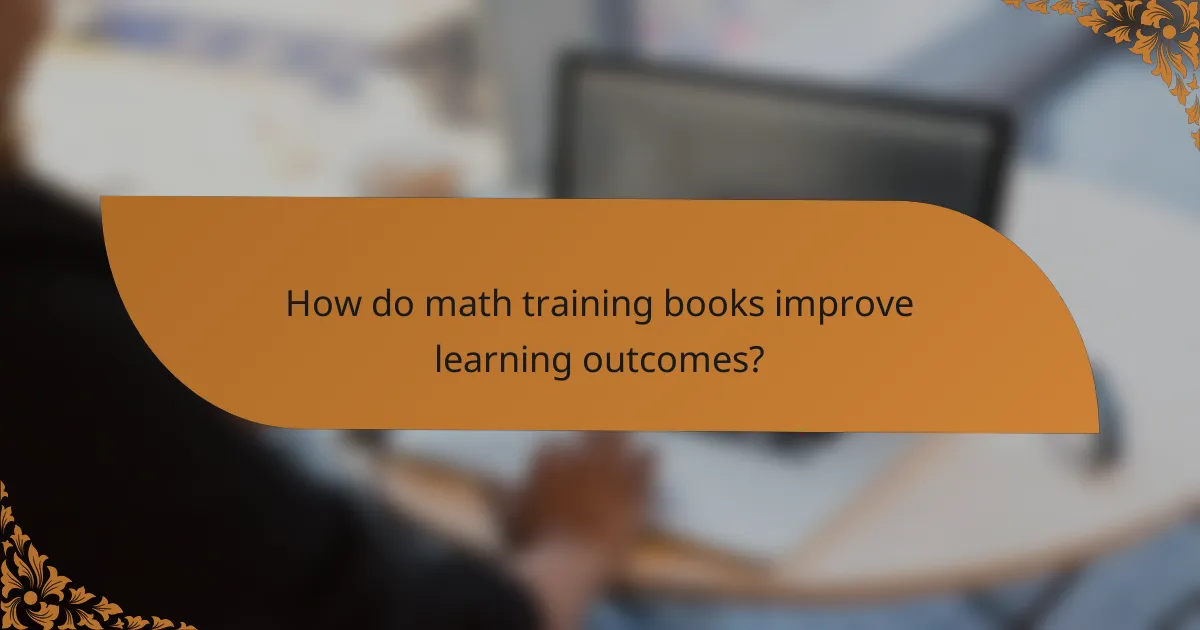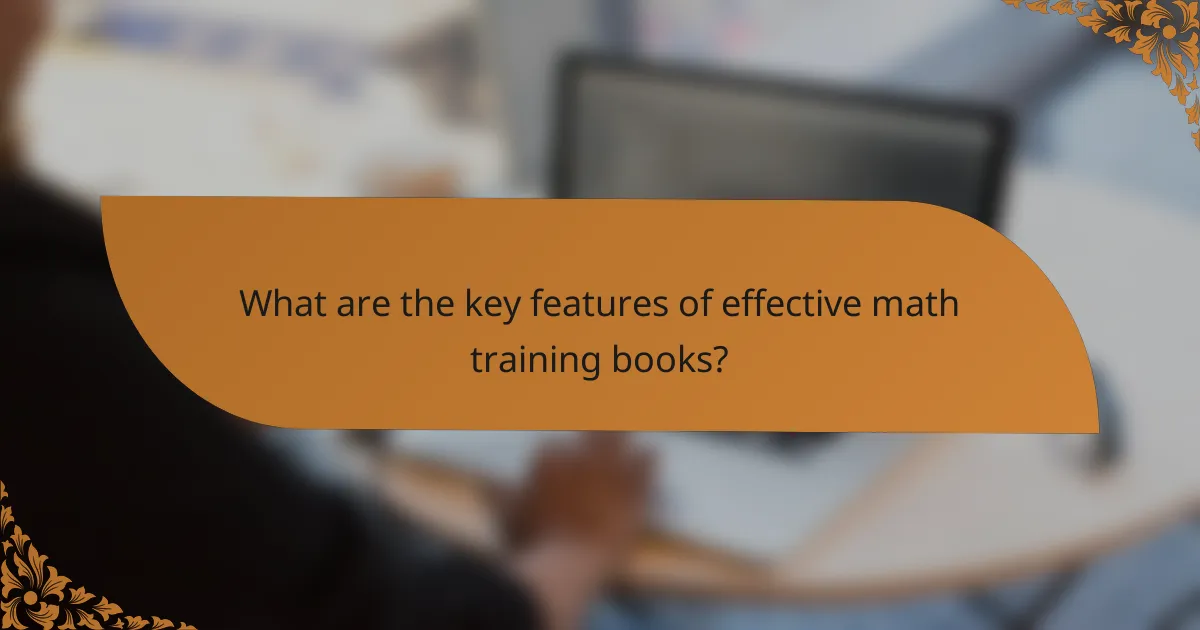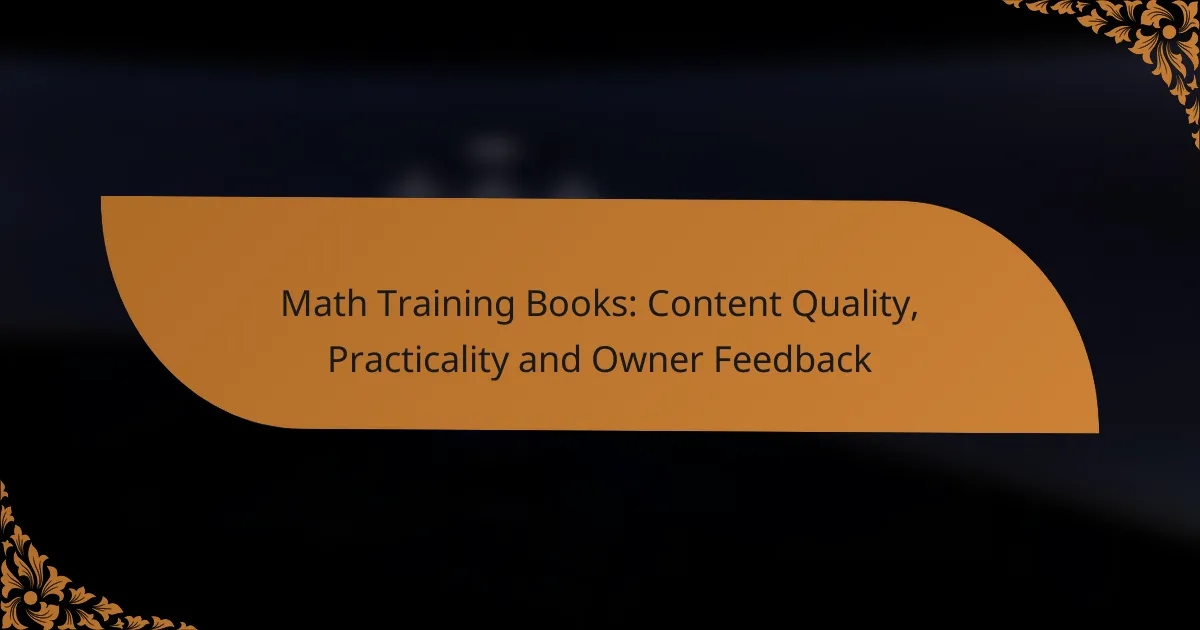Math training books play a crucial role in developing problem-solving skills and conceptual understanding for students in the US. By offering structured content and practical exercises, these resources enhance learning outcomes and prepare learners for various academic challenges. The combination of clear explanations and constructive feedback ensures that students can effectively grasp and apply mathematical principles in real-world situations.

What are the best math training books for students in the US?
The best math training books for students in the US focus on problem-solving skills, conceptual understanding, and practical applications. These books are designed to enhance mathematical thinking and prepare students for various challenges, including competitions and standardized tests.
“The Art of Problem Solving” series
The “Art of Problem Solving” series is renowned for its rigorous approach to mathematics, catering primarily to advanced students. It covers a range of topics from pre-algebra to calculus, emphasizing problem-solving techniques and critical thinking.
Students benefit from engaging exercises that encourage exploration and creativity in mathematics. The series is particularly useful for those preparing for math competitions, as it provides challenging problems and detailed solutions.
“Math Olympiad Challenges”
“Math Olympiad Challenges” is an excellent resource for students looking to excel in math competitions. This book compiles problems from past Math Olympiads, offering a variety of challenges that test different mathematical concepts.
By working through these problems, students can develop their analytical skills and learn effective strategies for tackling complex questions. This book is suitable for middle and high school students aiming to enhance their competitive math skills.
“Precalculus” by Michael Sullivan
Michael Sullivan’s “Precalculus” provides a comprehensive overview of precalculus topics, making it ideal for students preparing for calculus. The book covers functions, trigonometry, and analytical geometry, with clear explanations and numerous examples.
Students can expect to find practical applications of precalculus concepts, which helps in understanding their relevance in real-world scenarios. The book is structured to facilitate learning, with practice problems and exercises that reinforce key concepts.
“Algebra Unplugged” by Kenn Amdahl
This book uses humor and real-life examples to illustrate algebraic principles, which can help students overcome math anxiety. It’s particularly beneficial for those who struggle with traditional algebra textbooks, as it encourages a more intuitive understanding of the subject.

How do math training books improve learning outcomes?
Math training books enhance learning outcomes by providing structured content that reinforces concepts and offers practice opportunities. They help learners develop a deeper understanding of mathematical principles through varied exercises and explanations.
Enhanced problem-solving skills
Math training books often include a variety of problem types that challenge learners to apply concepts in different contexts. This exposure helps students build critical thinking and analytical skills essential for effective problem-solving.
For example, books may present word problems, puzzles, and real-world scenarios that require students to strategize and think creatively. Regular practice with these diverse problems can significantly improve a learner’s ability to tackle complex mathematical challenges.
Increased engagement with math concepts
Engagement with math concepts is heightened when learners interact with well-designed training books that present material in an accessible manner. Visual aids, examples, and interactive exercises can make learning more appealing and relatable.
Books that incorporate real-life applications or relatable scenarios can motivate students to see the relevance of math in their daily lives. Additionally, incorporating technology, such as QR codes linking to online resources, can further enhance engagement and provide a richer learning experience.

What are the key features of effective math training books?
Effective math training books combine clear explanations, practical exercises, and constructive feedback to enhance learning. These features help learners grasp concepts and apply them in real-world scenarios.
Clear explanations and examples
Clear explanations are essential for understanding mathematical concepts. A good math training book should break down complex ideas into simple, digestible parts, often using relatable examples to illustrate each point.
For instance, when explaining fractions, a book might use visual aids like pie charts or real-life scenarios, such as slicing a pizza, to make the concept more tangible. This approach helps readers connect theoretical knowledge with practical applications.
Practical exercises and solutions
Practical exercises are crucial for reinforcing learning and building confidence in math skills. Effective math training books should include a variety of exercises that range from basic problems to more challenging scenarios, allowing learners to practice at their own pace.
Additionally, providing solutions or detailed explanations for each exercise is vital. This feedback enables learners to identify mistakes, understand their reasoning, and improve their problem-solving strategies. A well-structured book might include a mix of multiple-choice questions, word problems, and step-by-step challenges to cater to different learning styles.

How to choose the right math training book?
Choosing the right math training book involves understanding your learning objectives and selecting a resource that aligns with those goals. Consider the book’s content quality, practicality, and feedback from other users to ensure it meets your needs.
Identify learning goals
Start by clarifying what you want to achieve with your math training. Are you looking to improve basic arithmetic skills, prepare for standardized tests, or delve into advanced topics like calculus? Defining your objectives will help narrow down your options.
For example, if your goal is to prepare for a specific exam, look for books that focus on that test’s format and content. If you’re seeking to build foundational skills, choose resources that emphasize practice and clear explanations.
Consider the book’s target audience
Different math training books cater to various audiences, such as elementary students, high school learners, or adult learners. Understanding the intended audience can guide you toward a book that matches your current skill level and learning style.
For instance, a book designed for high school students might include more complex problems and advanced concepts than one aimed at younger learners. Ensure that the language and examples resonate with you to enhance comprehension and engagement.
Evaluate reviews and ratings
Before purchasing a math training book, check online reviews and ratings from other readers. Look for feedback on the book’s clarity, effectiveness, and practical applications. High ratings and positive comments can indicate a quality resource.
Consider using platforms like Amazon or Goodreads to find user reviews. Pay attention to comments about how well the book helped others achieve their learning goals, and look for any recurring criticisms that might affect your decision.

What are the top-rated math training books based on owner feedback?
Top-rated math training books are highly regarded for their clarity, practical exercises, and effectiveness in improving math skills. Owner feedback often highlights how these resources help students grasp complex concepts and prepare for exams.
“How to Ace Your Math Exam”
This book is designed to equip students with strategies to excel in math exams. It emphasizes understanding the exam format, managing time effectively, and practicing with past papers to build confidence.
Key techniques include breaking down problems into manageable steps and using mnemonic devices for memorization. Students are encouraged to practice regularly and review their mistakes to avoid repeating them.
“Basic Math and Pre-Algebra” by Richard Rusczyk
Richard Rusczyk’s book focuses on foundational math concepts, making it ideal for learners who need a solid base before advancing. It covers essential topics such as fractions, decimals, and basic equations, presented in an engaging manner.
Readers appreciate the clear explanations and numerous practice problems that reinforce learning. The book encourages a hands-on approach, prompting students to work through examples and apply concepts in real-world scenarios.

What are the common pitfalls in selecting math training books?
Common pitfalls in selecting math training books include failing to assess the book’s difficulty level and neglecting the importance of practice problems. These mistakes can hinder effective learning and progress in mathematical skills.
Overlooking the book’s difficulty level
Choosing a math training book that does not match your current skill level can lead to frustration or boredom. If the material is too advanced, you may feel overwhelmed; if it’s too basic, you might lose interest. Always evaluate the book’s intended audience and difficulty rating before making a purchase.
Look for books that provide a clear description of their target audience, such as “beginner,” “intermediate,” or “advanced.” Additionally, consider reading reviews or sample pages to gauge whether the content aligns with your current understanding of math concepts.
Ignoring the importance of practice problems
Practice problems are essential for reinforcing the concepts learned in math training books. Books that lack sufficient exercises may not provide the necessary hands-on experience to solidify understanding. Seek out books that offer a variety of practice problems, including worked examples and solutions.
When evaluating a book, check if it includes sections for self-assessment or quizzes. A good rule of thumb is to choose books that feature at least one practice problem for every key concept introduced. This approach ensures you can apply what you’ve learned and track your progress effectively.
